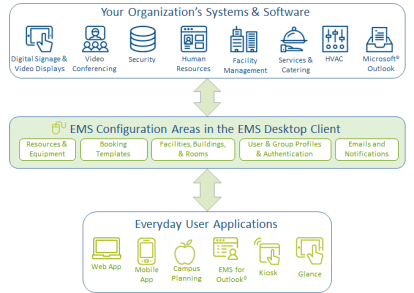What Are the EMS Software Components and What Do They Do?
EMS Desktop Client
The "core" administration system for all EMS Everyday User applications.
This desktop application is used by expert users to automate workflows and communications for maximum scheduling efficiency. This tool enables Everyday users to request space and services, see available space, check their calendar, check into meetings, change event details, end and cancel events, resolve booking conflicts, delegate space management to other users, send invitations, invoices, and notifications, approve requests, track resource usage, and track space utilization.
Configuration elements in EMS Desktop Client control what users can see and do in EMS Everyday User Applications
Expert users include conference center managers, event coordinators, registrars, facility and real estate managers, and service providers. They can use this tool to set up and control the booking process and booking templates, define space (buildings, rooms, floors, areas, and regions), define services, manage security and user permissions, grant access, initiate notifications and reports, and integrate with other applications, servers, databases, and systems. Everyday users, such as an employee who needs to book a conference room or a consultant who needs to book a hoteling space for the day, can use it to make reservations and book meetings.
Everyday User Applications
The following applications enable users to access EMS space management and scheduling functionality from the web, on mobile devices, digital kiosks, room signs, and displays.
|
EVERYDAY USER APPLICATIONS |
|
|---|---|
|
EMS Web App – Web-based space management This application provides extensive space management functionality so that web users, including guests and temporary visitors, can view and book space while on-the-go, using any web browser. |
|
|
Campus Planning Interface – Online academic planning This online event planning application provides higher education event planners and organizers a tool to review course schedule data and communicate changes throughout their organization. |
EMS for Outlook – Connects EMS with Outlook® Connecting EMS with your Microsoft® Outlook application enables users to book meetings and view user and space availability from Outlook, and sync calendars and activity with EMS applications. |
|
Digital Signage – Tablets and Room Signs EMS provides the following, optional licenses to integrate with digital tablets and room signs.
|
|
Additional Features
The following services and toolkits enable faster data integration and extend compatibility with other software applications your organization may already have.
|
ADDITIONAL FEATURES |
|
|---|---|
|
EMS API EMS APIs can be used to develop your own custom solutions for taking data from EMS and using it elsewhere, such as another software application, a digital sign, or a web page. You can purchase the API in Read-Only or Update packages. |
EMS Academic Planning This set of additional features adds functionality to EMS Desktop Client so academic users can manage space on-campus, such as connectors to sync and maintain terms/semesters, exam schedules, and course schedules, instructor information, and the integration of higher-education data from Student Information Systems (SIS). |
|
Integrated Authentication Provides single-sign-on capability using Integrated Windows Authentication (and IIS) , your organization’s portal, or LDAP. |
Integration to Exchange This service integrates EMS applications with Microsoft® Exchange and so users can view the availability of both meeting rooms and attendees, and send Outlook® meeting invitations, all from within EMS applications. Requires Exchange Web Services (EWS) impersonation. |
|
EMS Floor Plans This feature enables enhanced, interactive building floor plans and room layout images in EMS Web App and EMS Kiosk so users can search for, view and reserve available space based on location and proximity directly from the floor map images. Building floor plans and room layout images can show user location, room proximity and location on a campus and on a floor, and room drawings. |
Video Conference Equipment Interfaces with Cisco’s TMS and Polycom These optional EMS interfaces enable bookings to sync with your organization's existing VC software. Once configured, your bookings with VC equipment in EMS are automatically reflected in equipment scheduling and inventory tracked by your Cisco or Polycom applications. |
|
Facilities Management Data: Facilities Management Toolkit This toolkit integrates your organization's existing facilities management data and software systems with EMS to eliminate redundant data entry and maintenance. Administrators use it to automatically sync information about buildings, rooms, and areas and streamline the integration process. |
User and Group Profiles: Human Resources Toolkit This toolkit integrates your organization's existing HR data and software systems with EMS to eliminate redundant entry and maintenance of user records. Administrators use it to automatically sync information about users and groups and streamline the integration process. |
|
Digital Signage Interfaces
|
|